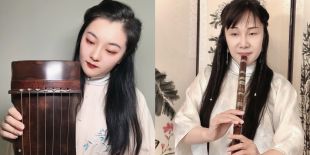
2:00 - 4:30
墨香如月— 一個以演奏中國傳統音樂為主的音樂組合,Ziying演奏古琴,Coral演奏洞簫。組合以“傳承精進,不忘初心:讓世界聽到中國古典音樂之美“為目標,致力於通過音樂教育、音樂會、講座和文化藝術節等活動,將中國傳統音樂帶到世界各地。組合希望通過演繹中國傳統音樂讓人們認識並了解中國古典音樂的美,並將這一珍貴的文化遺產傳承給後人。
MXRY is dedicated to enriching and inspiring audiences through the beautiful melodies of the guqin and xiao, as well as promoting traditional Chinese music culture. We strive to bring Chinese traditional music to communities worldwide through music education, concerts, lectures, and music festivals. Our mission is to introduce people to the beauty of Chinese classical music through our performances and to preserve this precious cultural heritage for future generations.
2-3:30 P.M. Guqin and Xiao Music Concert 左琴右簫音樂會
3:30-4:30 P.M. Explore various booths featuring traditional Chinese musical instruments, calligraphy, a riddle game with chances to win free gifts, and free Chinese language books. 探索各式攤位,包括中國傳統樂器、書法、有獎猜謎遊戲,以及免費中文書籍贈品。
本次活動由三藩市公立圖書館華裔中心和非牟利機構三藩市琴箫協會合作舉辦
This event is co-hosted by the Chinese Center of the San Francisco Public Library and the non-profit organization: San Francisco Guqin and Xiao Music Society.
古琴,原稱琴,又稱瑤琴、玉琴、五弦琴和七弦琴,是源自於中國的彈撥類樂器,有三千年以上歷史,屬於八音中的絲。古琴音域寬廣,音色深沈,餘音悠遠。自古「琴」為其特指,於1920年代起為了與鋼琴區別而改稱古琴,本文統稱琴。初為五弦,後增為七弦,且有標誌音位的13個徽,亦為禮器和樂律法器。
The guqin, originally called "qin" and also known as "yaoqin," "yuqin," "five-stringed qin," and "seven-stringed qin," is a plucked instrument originating from China with a history of over 3,000 years, classified as a "silk" instrument among the "eight sounds." The guqin has a wide tonal range, a deep and resonant timbre, and a lingering sound. Historically, "qin" referred specifically to this instrument, but since the 1920s, it has been called "guqin" to distinguish it from the piano. This text will refer to it simply as "qin." It initially had five strings, later increased to seven, and includes 13 markers called "hui" to denote pitch positions. It is also used in ritual and as a musical law instrument.
簫又稱洞簫、簫管,是中國古老的吹管樂器,特徵為單管、竪吹、開管、邊稜音發聲。「簫」字在唐代以前本指排簫,唐宋以來,由於單管竪吹的簫日漸流行,便稱編管簫為排簫,以示區別。至於「洞簫」之名,則來自於簫管底端之開孔。其音色圓潤輕柔,幽靜典雅,常用於獨奏、琴簫合奏或絲竹樂演奏。
The xiao, also known as dongxiao or xiao guan, is an ancient Chinese wind instrument characterized by a single pipe, vertical blowing, and an open-ended design, producing sound through edge tone. Before the Tang dynasty, the term "xiao" referred to the panpipes, but since the Tang and Song dynasties, the vertically blown single-pipe xiao became more popular, and the panpipes were renamed "paixiao" to distinguish between the two. The name "dongxiao" comes from the open hole at the bottom of the pipe. The xiao produces a mellow, soft, and elegant sound, often used for solo performances, qin and xiao duets, or in silk and bamboo ensemble music.
根據查阜西1954年2月26日的簡短筆記,對琴簫合奏歷史的理解大致如下:
琴簫合奏形式在漢代十分常見,漢代的樂俑和繪畫材料便可作為佐證,這是琴學專家在20世紀50年代所發現的。
漢代之後,琴簫合奏逐漸衰落,最終失傳,直到在清代的文獻中被重新發現。然而,由周顯祖在清代嘉慶年間編寫的《琴簫合譜》並未受到琴學專家的重視。
現存的琴簫合奏形式是一種20世紀琴學專家研究和發掘的表演風格,其合奏方法來源於《琴簫合譜》。
According to Cha Fuxi's brief note written on February 26, 1954, the history of the qin-xiao ensemble as understood during that time can be outlined as follows:
The form of qin-xiao ensemble was commonly present during the Han Dynasty, as evidenced by the Han Dynasty musical figurines and painting materials discovered by qin experts in the 1950s.
After the Han Dynasty, the qin-xiao ensemble gradually declined and eventually became lost until it was rediscovered in written materials from the Qing Dynasty. However, "The Score of Qin-Xiao Ensemble" (compiled by Zhou Xianzu during the Jiaqing period of the Qing Dynasty) did not receive much attention from qin experts.
The existing form of qin-xiao ensemble is a performance style researched and excavated by qin experts in the 20th century, and its ensemble method is derived from "The Score of Qin-Xiao Ensemble."

